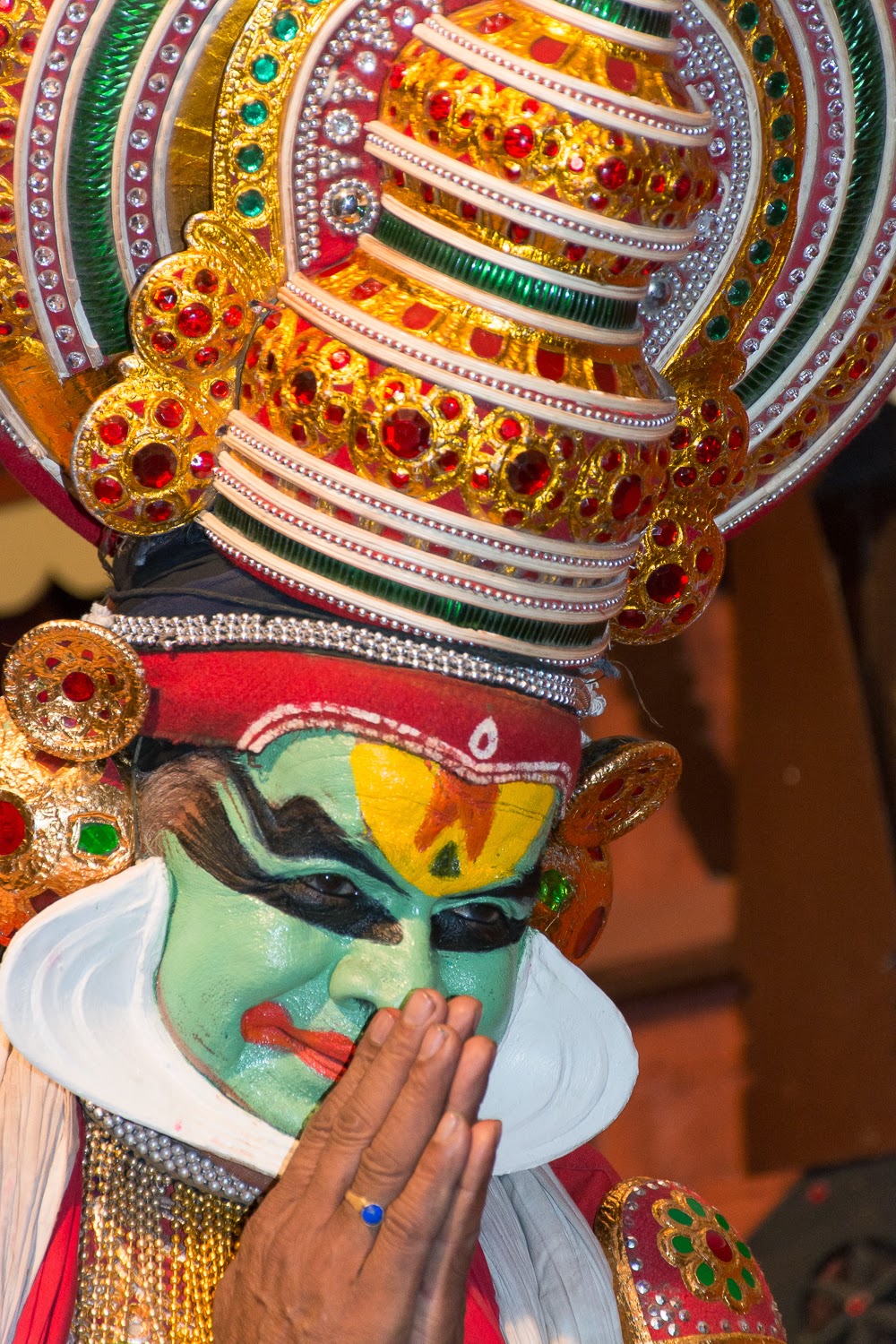After leaving Periyar National Park we headed west to Kumarakom on the shore of Vembanad Lake, the largest lake in the state of Kerala. The big draw here is to explore the network of canals and lakes that make up the 2,034 square km (772 square miles) Vembanad Wetlands system, the largest in India. Houseboats are used to get around the waterways. Up until about 30 years ago, cargo boats were used to transport spices, rice and other cargo from the interior to the Arabian Sea. When cheaper modes of transport became available, the cargo boats became obsolete. Some ingenious person came up with the idea to convert them to houseboats called kettuvallams and a new tourist trade was born. Today there are more than 1000 houseboats plying the backwaters of Kerala so it's a good idea that has become too popular. We boarded our houseboat the Neyyar and settled in on the upper deck with a fresh coconut water drink.
 |
| Peggy on the Upper Deck of our Houseboat |
Along the canals people grow rice, bananas, mangos and coconuts. The rice paddies and people's homes are actually below the level of the water. In fact almost half of the backwaters are 3 feet below sea level and are separated from the Arabian Sea by a narrow barrier island.
 |
| Paddling the Backwaters of Kerala |
We got into a smaller boat to explore some of the narrower channels. Along the way women were doing laundry by slapping the clothes against a rock with a loud whack, whack. Others were bathing or fishing.
 |
| Woman Fishing in Kerala |
We returned to our houseboat past a line of other kettuvallams and enjoyed dinner on board and a comfortable night in our air conditioned "stateroom". We were up early the next morning and watched a local man in a long boat paddle from houseboat to houseboat collecting plastic bottles.
 |
| Collecting Plastic Bottles |
As far as we could tell, the houseboat operators were trying to be eco-friendly. The kettuvallams are constructed of local, biodegradable materials; bamboo poles, coconut fibre ropes, bamboo mats and carpets. The hull is made of hundreds of planks of "Anjili" or jack wood (Artocarpus hirsuta) held together by coir ropes, a natural fiber made from coconut husks. Not a single nail is used!
 |
| Kettuvallams in Kerela |
After our Backwater cruise we drove north to the port city of Cochin. That evening we attended a Kathakali show. Kathakali is an art form more than 400 years old and literally means story-play. The performers apply face paint, a painstaking process which we arrived an hour early to witness.
 |
| Applying Face Paint for a Kathakali Performance |
One of the performers transformed himself into a woman (only men perform kathakali).
 |
| The End Result (female) |
The other performer applied bright green, red and black face paint to give him a princely look. I thought he looked more like a member of the 70's rock group Kiss!
 |
| The End Result (male) |
The female character, played by a master actor at performing kathakali, demonstrated the control "she" had over 'her' eye movements. He rolled his eyes to the beating of a drum.
 |
| Kathakali Master |
He also demonstrated the facial and hand gestures that are used to tell a story. Not a word is uttered during a performance. Can you guess which emotion is being depicted in the photo below?
 |
| Kathakali Master showing Anger? |
A play was enacted whose story line goes something like this. A handsome prince meets a beautiful woman who tries to seduce him.
 |
| Kathakali Performance |
The prince being happily married tries to thwart her advances.
 |
| Kathakali Performance |
The woman becomes enraged and turns into a demoness. The prince whips out his sword and cuts off one of her breasts, putting an end to her unwanted advances.
 |
| Kathakali Performance |
The prince, triumphant in his defeat of temptation, bows to the audience.
 |
| End of the Performance |
It's a good thing that nowadays men just give in to the advances of women and don't take such drastic measure to fight them off!
The following morning we visited Fort Kochi. It is here that Europeans first set foot in India. St Francis Church was built in 1503 by the Portuguese as a Catholic church. Portuguese explorer Vasco de Gama was once buried in this church which now falls under the Church of South India and is one of India's national monuments.
 |
| St. Francis Church, Fort Kochi |
The landmark that draws the most visitors is a series of pre-colonial Chinese fishing nets on the waterfront, believed to have been introduced by Chinese traders in the early 14th century.
 |
| Chinese Fishing Nets |
The nets are attached to wooden beams and lowered into the water. After being submerged for awhile, they are lifted by ropes from which large rocks are suspended to act as a counterweight. We "helped" lift one of the nets by pulling on the ropes. I'm not sure if we caught anything.
 |
| Raising a Chinese Fishing Net |
Our trip to southern India concluded in Cochin. Tomorrow we fly to Delhi to start the next phase of our journey, a visit to the tiger parks in central and northeast India.
We hope all is well back home.
Peggy and Marc

2 comments:
How do you see the future of these houseboats? God forbid if these huge cruise ships even think about about a new voyage!
So,glad the actors were only make believe! What artistic work!
We were told that the government is not issuing any new houseboat permits so at least the number will stabilize. It's a good thing that the canals are too narrow for huge cruise ships.
Post a Comment